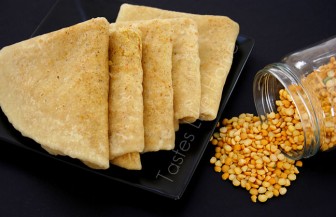Hi Everyone, the recipe I get the most requests for is dhal puri. The requests do not only come from Caribbean people within and outside the region but they also come from another place that is well known for its dholl purri – Mauritius.
Mauritius, like the Caribbean, is a multi-cultural society and celebrates many of the same festivals and holidays like we do, such as Holi/Phagwah, that’s being celebrated tomorrow. The dhal puri recipe requests that come from Mauritius are more for comparison, the Mauritians want to know how similar or different our dhal puri is to theirs. While there are many similarities, the main differences are that they do not put baking powder in theirs as we do in ours and they add turmeric (dye) to the dough to give it that golden colour. An excellent tip I picked up from a Mauritian friend who shared his family recipe, is that they reserve the water that the peas was boiled in and use it to make the dough for their dhal puri.
 With Holi/Phagwah being celebrated tomorrow, one thing for sure that will be on many tables is a large stack of dhal puri. And, I thought that I would share with you some information and tips I have picked up along the way while making that elusive dhal puri.
With Holi/Phagwah being celebrated tomorrow, one thing for sure that will be on many tables is a large stack of dhal puri. And, I thought that I would share with you some information and tips I have picked up along the way while making that elusive dhal puri.
Let me declare early that I believe that roti-making of any kind is an art and that like many things, it takes practice to perfect. Each time you make it, you get better at it because each time, you learn to master different aspects of roti making – whether it is kneading the dough, forming the dough to be able to roll perfectly round roti(s) or understanding the heat temperature at which to cook the roti. My advice is to not lose faith if your first attempt at making roti is not as successful as you’d hoped; the more often you make roti, the better you become at it. I know that is certainly true for me. If you’ve read my book, you’d know that I have been making roti before I was even a teenager, and yet, when I make any type of roti today, I learn something new or interesting from the process.
Let’s make some dhal puri.
The peas
Wash the split peas and soak them overnight. The overnight soaking not only hydrates the peas but it helps them to cook up faster.
The next morning, rinse the peas well until the water runs clear. Put it in a saucepan with water about 2 – 3 inches above the peas, cover the pot slightly and bring it to a boil. When the peas come to a boil, add salt to taste. This is the best time to season the peas, not after they are ground up. If you add salt when the peas are finished grinding, you will feel the grains of salt that will then melt while the stuffed dough is resting and it will make rolling difficult because the dough will become moist.

Let the peas cook until they are al denté – with a bite to it. The outside should be cooked but the inside a little hard but not raw. Strain the peas well in a colander and then spread them out on a flat surface or a large baking sheet lined with paper towels and leave them to air-dry, removing the excess moisture. If the peas are wet, then they will cake-up and be pasty when ground up; you do not want that. The filling needs to be loose and fluffy.
Seasoning
If you can, always use freshly ground jeera (cumin). Garlic and hot pepper are the other ingredients for flavour. If you can, add some fresh cilantro (coriander) to the mix, it really adds a nice flavour to the dhal puri.
Equipment
You won’t find a bigger fan of using old-time kitchen tools and equipment than me, but for grinding the peas for dhal puri, a food processor makes excellent and fast work of the job. Hands down, this is the way to go. Growing up, we would use a mill, screwed on to the counter top.
I usually add the garlic and the pepper to the food processer first and give it a few whirls to mince, and then I add the peas and cilantro. Be sure to scrape down the sides of the bowl of the food processor. Pulse until the peas are pulverized – they should be loose, not pasty and they should definitely not stick together. Empty into a bowl add the freshly ground cumin, mix and fluff with a fork.
Puri dough
Each household, each country within the region has its own ratio of flour to baking powder when it comes to making various types of roti(s). For dhal puri, I use one measured teaspoon of baking powder to one cup of flour. Now when I talk about teaspoons and cups here, I am not talking about the stuff we use to eat and drink with daily, I am referring to standard measuring spoons and cups, so please be guided accordingly.
Add a pinch of salt, sugar and some oil to the dough. Use warm water to knead the dough (about 100 – 105 degrees F). The warm water jump starts the gluten and leavening agent. Once the dough comes together, knead it for 3 minutes then rub some oil all over the dough and cover it and let is rest for at least 30 minutes before you start working with it.
Puri filling
Follow your recipe and cut the dough into the number of equal pieces suggested. Form the dough into little balls and then flatten each ball to about 2 – 3 inches, cup it and fill with the seasoned pea filling. Never overstuff the dough. The middle should always be thicker than the ends. Bring the sides of the dough together and pinch it secure. Dab a little oil on top of the dough and cover it. This is to prevent a ‘skin’ forming on the dough. Repeat until all the dhal puri is filled.
After filling the dhal puri, you can do one of two things, let them then rest for a half hour before cooking or cook the dhal puri right away starting with the first one that was filled. I am not sure if this part makes a difference but what I have always done is to let the filled puri(s) rest for half an hour because it gives the dough some time to set after all the handling.
Rolling the puri
Make sure that you have an ample rolling surface. Flour the work surface and the rolling pin. Take one of the stuffed pieces of dough and dust it in flour, place it in the middle of the work surface, flatten it with your hand and then start rolling it. Turn it at a 90-degree angle and keep rolling it; you want to roll it out as thinly as possible.
You can flip the puri over to roll the other side if you like but I have always had great success by rolling it on one side and turning it at an angle to get the round shape.
Cooking the puri
One of the things that you must take into consideration when making any roti, is the size of your pan or tawah. If you have a large tawah then make large roti(s) but if you have a small tawah, then please make small roti(s). Roti making has to do with a certain consistency in the thickness/thinness of the dough, if this is not right, the results of the end product would be altered and not to be your satisfaction. So please bear this in mind. You never want to roll the dough so wide that it cannot fit on the tawah and you have to scramble to pull the dough where it overlaps on the tawah.
Dhal puri cooks up quickly, in about a minute if that long. All you are really doing is lightly cooking the thin dough – the filling is already cooked. Medium heat is what I would recommend (of course this would depend on the size of your burner). Make sure that the tawah is properly heated, if it is not, then the puri would cook and be fine but it would not rise and puff up as it generally does.
Some people brush the tawah with oil before placing the puri on it to cook and some don’t. I am the latter. I add the puri just like that to the tawah, wait for it to puff up, flip the puri, brush with oil, flip, brush again, give a last flip and then remove it from the tawah.
Stacking the puri
Place a 4-inch square piece of grease-proof/wax paper between each dhal puri as it finishes cooking. This will avoid them steaming up and sticking to each other. Puri is always best eaten when still very warm.
I hope that your dhal puri-making is a success this weekend and always. Remember, do not be disheartened if your first attempt is not as successful as you would like it to be. The more often you make it, the better you will be become.
Happy Phagwah!
Cynthia
Dhal Puri
(Tastes Like Home – My Caribbean Cookbook)
Yield: 10 – 12
Ingredients
Dough
4 cups all purpose flour
4 teaspoons baking powder
1 teaspoon sugar
½ teaspoon salt
1 tablespoon oil
1¼ cups warm water to knead a soft dough (a little more water may be needed)
Filling
● 1 cup yellow split-peas (soaked over night)
● Water to cook peas
● Salt to taste
● 4 large cloves garlic, chopped
● Hot pepper to taste, chopped
● 1¼ teaspoons ground jeera (cumin)
For cooking
● Oil to brush both sides of the dhal puri
● Additional flour for dusting and rolling
Equipment
1 large bowl
Plastic wrap
1 medium saucepan
1 large spoon
1 colander
1 food processor
1 medium bowl
1 fork
1 baking sheet, lightly oiled
1 rolling pin
1 tawah (flat iron griddle)
1 flat spatula
1 small bowl with oil to brush on dhal puri
1 pastry brush
12 (4-inch square) pieces wax paper
1 large plate lined with tea towel and wax paper
Directions
Dough
1. Mix flour, baking powder, salt and sugar in large bowl.
2. Drizzle oil into flour mixture and incorporate.
3. Add warm water and knead ingredients to make a soft, pliable dough. Knead for 3 minutes.
4. Rub dough lightly all over with oil, cover with plastic wrap and let rest for at least 30 minutes.
Filling
5. Wash soaked peas, add to saucepan with water and salt to taste and bring to a boil.
6. Let peas cook until al denté (with a bite to it). Be sure not to cook the peas until soft. The split peas should still be whole and firm but definitely not raw. Check after 5 minutes of boiling.
7. Drain in colander; let peas air dry, leave it uncovered for 5 – 10 minutes
8. Add the boiled peas, garlic and hot pepper to food processor.
9. Pulse until the mixture is of a very fine cornmeal; mixture should not be like a paste, it should be able to fluff with a fork.
10. Empty the processed peas into medium bowl, add ground jeera (cumin), mixing thoroughly with a fork.
Combining dough and filling
11. Knead rested dough for 1 – 2 minutes.
12. Cut dough into sizes a little larger than golf balls.
13. Pat each piece of dough into a round disk, about 3 inches.
14. Now you can do this part 2 ways: place the disk on a flat surface scoop up some of the seasoned split peas, place it in the middle of the flattened dough and bring the ends together, pinching and enclosing the stuffing. Or take the flattened dough and place it in one hand, cupping it. Scoop some of the seasoned filling into the dough-cup. Carefully grab the ends of the dough and pinch it to seal in the stuffing.
15. Place stuffed dough, seam-side down on baking sheet (or whatever surface you are using).
16. Pat each stuffed dough-ball with a little bit oil so that a dry skin does not develop.
17. Continue stuffing the balls of dough with the seasoned split peas until done.
18. Cover with plastic wrap and let rest for 20 – 30 minutes.
Cooking the dhal puri
Now it’s time to cook the dhal puri. Some people like their dhal puri with tiny, toasted brown spots and some don’t, either way it does not matter, it’s a matter of personal preference. Personally, I don’t mind the little brown spots.
1. Heat the tawah (flat iron-griddle) on medium to medium-low heat.
2. Flour work surface and rolling pin.
3. Using your hands, form a round disk of the stuffed dough-ball; gently and carefully press just off from the centre to the ends, this way you are starting to distribute the filling to the ends.
4. Place on floured surface and roll dough thinly. You can opt to roll on one side only, constantly turning the dough at a 90-degree angle or you can flip the dough over, back and forth and roll.
5. Carefully lift rolled dough and place on heated tawah.
6. As soon as you start to see the dhal puri puff up with little bubbles, turn the dhal puri on the other side to cook and in the mean time, brush the now cooked side with some oil, be sure to brush the edges also.
7. Turn dhal puri and brush the other cooked side.
8. Turn one more time ensuring the dhal puri is cooked. Using a spatula, remove dhal puri from tawah and place on lined plate.
9. Repeat this process until all the dhal puri is cooked and ensuring that you put a piece of the cut waxed paper between each dhal puri, this will prevent them from sticking to each other and steaming.
10. Serve hot or at room temperature with any curry or it can be eaten as is or with a dab of achar or sour.









